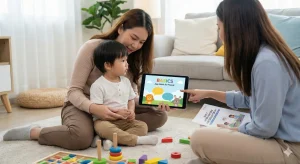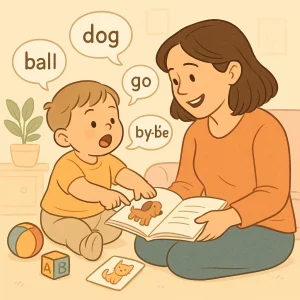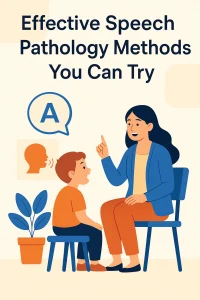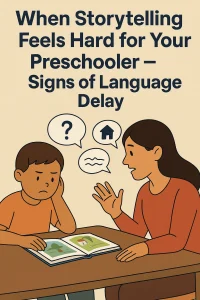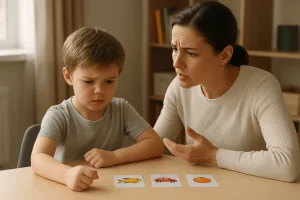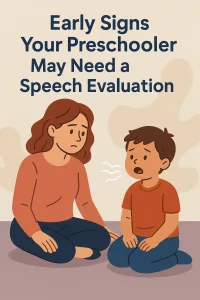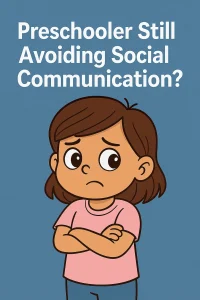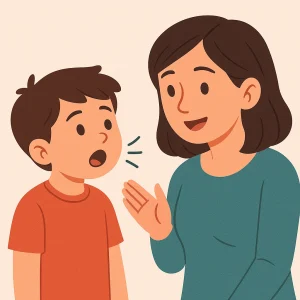Help Child Master /s/ Sound: Fun Activities & Pro Tips
By Rajini D
Last Updated: March 28, 2024
Have you ever listened to children’s sweet chatter and noticed how some of them stretch the /s/ sound, turning “sun” into “thun”? It’s quite common, and if your little one is navigating this speech adventure, they’re in great company. Mastering the /s/ sound is a milestone many kids work toward, each at their own pace. This sound, essential for clear communication, can be tricky due to its specific tongue placement and frequency in the English language.
But here’s the good news: This challenge is widely understood and, more importantly, solvable. Early intervention and regular, playful practice can make a world of difference. Imagine the joy and confidence your child will feel as they master the /s/ sound, clearly expressing their thoughts and needs. It’s about laying down the stepping stones for effective communication, one sound at a time.
Understanding the /s/ Sound
The /s/ sound, while seemingly simple, holds a unique place in the English language. It’s like the secret ingredient that gives words their clarity and crispness. But what makes this sound particularly challenging for children to master?
At its core, the /s/ sound is produced by channeling air through a narrow passage formed by the tongue and the roof of the mouth, right behind the front teeth. This airstream then escapes between the teeth, creating that familiar hiss. It’s a bit like a whisper but sharper and more focused. The complexity lies in the precision required: too much air or slightly off-tongue placement, and the sound shifts, becoming something else entirely.
For a deeper dive into speech production, our article on the speech chain provides insight into how sounds form.
Common Mispronunciations: Navigating Through Lisps
Many children encounter hurdles with the /s/ sound, often manifesting as lisps. A lisp can color the /s/ sound, turning it into a “th” sound (“sun” becomes “then”) or causing it to sound slushy as if the air isn’t directed properly. These variations are more than just speech quirks; they signal that a child is finding their way through the intricate landscape of speech sounds.
Frontal Lisp:
- Here, the tongue pokes through the teeth. Imagine trying to whisper a secret, but your tongue decides to peek out and say hello!
Lateral Lisp:
- This one is a bit like a leaky tire. The air, instead of flowing straight out, takes a detour over the sides of the tongue, creating a wetter, less distinct sound.
When to Start Worrying and Seeking Help
Witnessing your child’s speech development is a journey filled with milestones and memorable moments. Yet, it’s natural for parents to wonder if and when they should be concerned about their child’s pronunciation skills, especially regarding the elusive /s/ sound. Let’s navigate these waters together, focusing on understanding, not worrying.
Understanding Speech Development Milestones
Every child’s path to clear speech unfolds uniquely. Typically, children start experimenting with various sounds early in life, but mastering them takes time and practice. The /s/ sound, with its precise tongue placement, can be one of the trickier sounds for children to get right. Generally, children are expected to master the /s/ sound by the age of 4 to 5 years. However, it’s not uncommon for some kids to perfect this sound a bit later.
Recognizing Individual Variability
It’s crucial to remember that variability is the norm when it comes to speech development. Some children might sprint through all their speech milestones early on, while others take a more leisurely pace. This variability doesn’t necessarily signal a problem. Speech development is a complex process influenced by a range of factors, including physical development, environmental exposure, and individual learning styles.
Signs It Might Be Time for Professional Insight
While patience and encouragement are key, there are signs that might indicate the need for professional advice:
- Persistence of the /s/ sound mispronunciation beyond the age of 5.
- Frustration or self-consciousness in your child about their speech.
- Difficulty being understood by familiar listeners (family, close friends) after the age of 4.
- Social withdrawal or reluctance to speak due to their speech challenges.
If you notice these signs, consider consulting with a speech-language pathologist (SLP). These professionals can offer a comprehensive evaluation of your child’s speech and language skills, providing peace of mind and, if necessary, a path forward.
Explore our article on Early Identification Warning Signs in Child Development.
The Role of Speech Therapy
When we think about speech therapy, it’s common to picture it as a solution designed solely for correcting specific speech issues. However, it’s so much more than that. Speech therapy is a supportive, empowering tool that not only aids in correcting pronunciation difficulties but also bolsters confidence and enhances overall communication skills. It’s about giving your child the keys to express themselves clearly and confidently in the world around them.
Speech therapists, particularly those associated with Wellness Hub, approach each child as an individual with unique needs and potential. When it comes to the /s/ sound, which can be a stumbling block for many children, our therapists employ customized strategies designed to meet each child where they are in their speech development journey. This personalized approach ensures that therapy is not just effective but also engaging and enjoyable for your child.
Customized Strategies for Success
At Wellness Hub, our speech therapists use a variety of techniques to help children master the /s/ sound. These strategies might include:
- Visual and tactile cues to help children understand where their tongue should be positioned.
- Fun and interactive games that incorporate the /s/ sound, making practice feel more like play.
- Parental involvement in therapy sessions to ensure that practice continues at home, seamlessly integrating into daily routines.
The Benefits of Speech Therapy
Engaging in speech therapy offers numerous benefits, extending beyond pronunciation improvement:
- Enhanced confidence in speaking situations, as children feel more understood by their peers and adults.
- Improved academic performance, as well as clear communication, is key to learning and classroom participation.
- Better social skills, as children who communicate effectively are more likely to participate in group activities and form friendships.
Learn more about the benefits of speech therapy for children with Speech Therapy for Autism.
Home Practices to Support Pronunciation
Crafting a nurturing environment for your child’s speech development can be both a joyful journey and a golden opportunity for bonding. Integrating simple, engaging activities into your daily routine not only supports the mastery of tricky sounds like the /s/ but also turns practice into a shared adventure. Here are some fun, easy exercises to help your child with the /s/ sound, transforming learning into play.
1. The Snake Sound Game
Children love animals, and what better way to practice the /s/ sound than by mimicking our slithery friend, the snake? This game is all about making the /s/ sound long and drawn out, just like a snake’s hiss. Encourage your child to be a “snake” for the day. Every time they speak the /s/ sound correctly, celebrate their success with a fun snake dance or by drawing a colorful snake together. This visual and auditory connection makes learning memorable and enjoyable.
2. The Exploding /T/ Technique
This technique is a fun way to transition from a sound that your child likely already makes well, the /t/, to mastering the /s/ sound. Have your child say the /t/ sound repeatedly in a row (t-t-t-t) and then elongate the last one into an /s/ sound (t-t-t-ssss). It mimics the buildup of a rocket launch, ending with the “explosion” into the /s/ sound. You can make this even more engaging by drawing rockets or making a simple craft together, where every successful sound launch adds a part to the rocket.
3. Fun with Soap Bubbles
Who doesn’t love bubbles? This activity uses the natural action of blowing to encourage the correct mouth shape and breath control for the /s/ sound. Blowing bubbles can help your child practice the necessary airflow without even realizing they’re working on their pronunciation. Turn it into a game by counting how many bubbles they can pop with just the /s/ sound or seeing how big a bubble they can make by extending the /s/ sound as long as possible.
4. Search for the /S/
Create a scavenger hunt in your home or garden for items that start with the /s/ sound. This activity is not only great for practicing the sound but also for building vocabulary and understanding the role of the sound in different words. Each item found can be celebrated with an /s/ sound cheer, integrating movement with learning to engage your child fully.
5. Storytime with /S/
Choose books with a focus on the /s/ sound or characters whose names start with /s/. As you read together, emphasize the /s/ sound and pause to let your child try the sound in a word or phrase. You can also create stories together, with your child adding sentences that contain the /s/ sound. This activity encourages creativity, listening skills, and pronunciation practice in a relaxed, supportive setting.
Engagement Over Perfection
Remember, the goal of these activities is to make practice enjoyable and to encourage effort over perfection. Celebrate every attempt and progress, showing your child that learning is a journey filled with fun discoveries. By integrating these simple exercises into your daily interactions, you’re not only supporting your child’s speech development but also strengthening your bond with them through shared success and laughter.
Enhancing /s/ Sound Practice Through Creative Activities
| Time of Day | Activity | How to Incorporate /s/ Sound Practice |
|---|---|---|
| Morning Routine | Getting Dressed | While choosing clothes, emphasize clothing items that start with the /s/ sound, like “shirt,” “shorts,” or “socks.” Ask your child to pick their “socks” or “shirt,” encouraging them to pronounce the /s/ sound clearly. |
| Mid-Morning | Snack Time | Prepare snacks that start with the /s/ sound, such as “slices” of apples or “string” cheese. Discuss the snacks using the /s/ sound, making snack time both educational and nutritious. |
| Lunch | Story Creation | Create a story together using as many /s/ words as possible. Take turns with your child to add sentences to the story, focusing on the use of the /s/ sound. This activity boosts creativity while practicing speech. |
| Afternoon | Art and Craft | Engage in an art project that involves items starting with /s/, like drawing “stars,” “sun,” or making “slime.” Discuss each item as you create, emphasizing the /s/ sound in a fun, artistic context. |
| Evening | Dinner Conversation | Initiate a conversation where each family member shares something about their day that involves the /s/ sound. This could be activities they did, people they met, or things they saw, encouraging the use of the /s/ sound in natural conversation. |
For more fun and effective speech therapy activities, check out Home-based Speech Therapy Activities.
The Importance of Regular Practice
Regular practice is the cornerstone of mastering any skill, especially when it comes to the nuanced world of pronunciation. While professional speech therapy lays a solid foundation for correct pronunciation, the magic truly happens in the everyday moments at home. Consistent practice at home not only reinforces what’s learned during therapy sessions but also integrates speech improvement into your child’s natural communication habits. Here’s how you can weave speech practice into daily routines without it feeling like another chore on the list.
1. Make It Part of Your Daily Conversations
Incorporate practice into the natural flow of your day-to-day conversations. Highlight words that have the /s/ sound and gently encourage your child to repeat them during different activities, whether it’s during mealtime, bath time, or while playing. This method ensures practice feels less like a task and more like an engaging part of interacting with each other.
2. Use Technology Wisely
In today’s digital age, smart use of technology can be a game-changer for practicing speech. There are numerous apps designed to make speech practice fun and interactive. Allocating a small portion of screen time to these educational apps can make practice something your child looks forward to each day.
3. Create a Routine, But Keep It Flexible
Having a routine helps embed practice into your child’s daily life, but flexibility is key. If your usual practice time isn’t working on a particular day, switch it up. The goal is to make speech practice a positive and stress-free experience. Maybe some days, practice happens on the way to school, and other times, it’s part of the bedtime routine. What matters is consistency, not the clock.
4. Engage in Storytelling and Reading Together
Reading together is a powerful tool for speech practice. Choose books with plenty of /s/ sounds and emphasize these sounds as you read. Ask your child to tell you stories, too. This not only practices the /s/ sound but also encourages imagination and creativity.
5. Celebrate Efforts and Progress
Every attempt at the /s/ sound, successful or not, is a step forward. Celebrate these efforts with lots of praise and encouragement. Recognizing progress, no matter how small boosts your child’s confidence and motivation to keep practicing.
Daily Routine Integration for /s/ Sound Practice
| Time of Day | Activity | How to Incorporate /s/ Sound Practice |
|---|---|---|
| Morning | Breakfast Time | Start the day by discussing and naming foods that start with the /s/ sound, such as “cereal,” “strawberries,” or “sandwiches.” Encourage your child to request /s/ foods, enhancing their awareness and usage of the sound in a natural context. |
| Afternoon | Playtime/Outdoor Time | Engage in the “Snake Sound Game,” where your child hisses like a snake every time they slide, swings, or runs. Alternatively, play “Secret Spy Missions,” searching for objects that start with /s/, such as “stones,” “sticks,” or “slides,” making the activity an adventurous learning experience. |
| Evening | Storytime/Bedtime | Dedicate time to read books that feature a lot of /s/ sounds or have characters whose names start with /s/. Emphasize and practice these sounds together, turning reading time into an interactive speech session. Ask your child to retell parts of the story using /s/ words to reinforce their learning. |
For insights on enhancing your child’s communication skills at home, delve into Developing Your Child’s Communication Skills: Question Quest.
Conclusion
As we conclude our exploration of assisting children in mastering the /s/ sound, let’s hold onto the truth that progress is built on a foundation of patience, consistent practice, and a positive outlook. The journey of speech development for each child is distinct and filled with its own set of milestones and moments of triumph. It’s crucial to celebrate these steps, no matter how small, recognizing that every effort brings your child closer to clear and confident communication.
Wellness Hub stands as a steadfast ally on this journey, offering a suite of resources and expert guidance tailored to support your family every step of the way. We believe that with the right mix of encouragement and practical strategies, navigating the path of speech development can be a fulfilling experience. As we move forward, remember that we are here to support not just the growth of your child’s communication skills but their overall wellness and happiness. Together, we can unlock the full potential of their voice, ensuring a future where every word is heard and cherished.
Frequently Asked Questions:
1. At what age should my child master the /s/ sound?
Children typically master the /s/ sound by 4 to 5 years old. However, speech development varies, so if your child is struggling beyond this age, it might be beneficial to seek advice from a speech therapist who can offer personalized guidance and support based on your child’s needs.
2. How can I help my child practice the /s/ sound at home?
Incorporating fun, daily activities like the snake sound game, bubble blowing, or reading books with plenty of /s/ sounds can significantly aid in practicing the /s/ sound. These enjoyable exercises encourage children to practice without the process feeling like a chore, fostering a positive and supportive learning environment at home.
3. What are the signs that my child might need speech therapy?
If your child frequently mispronounces the /s/ sound beyond the age of 5, expresses frustration with their speech, or tends to avoid speaking, these could be indicators that professional speech therapy might be beneficial. A speech therapist can assess your child’s needs and provide targeted strategies to improve their pronunciation skills.
4. Can technology help with speech development?
Yes, technology can be a valuable ally in speech development. Educational apps designed for speech practice offer interactive and engaging ways for children to hone their pronunciation skills, making therapy sessions more appealing. These digital tools support regular practice in a fun, accessible manner.
5. How does Wellness Hub support speech development?
Wellness Hub supports children’s speech development through a comprehensive approach that includes access to professional speech therapists, educational content, and interactive activities. Our resources are designed to engage children in their speech improvement journey, making learning enjoyable while effectively addressing individual speech challenges.
6. What role does regular practice play in speech development?
Regular practice is essential in speech development as it reinforces the lessons learned during speech therapy sessions and helps integrate correct pronunciation into everyday use. By weaving practice into daily routines, parents ensure that children have ample opportunities to improve their speech in a natural, stress-free environment, significantly boosting their progress and confidence.
7. How long does it typically take to see improvement in my child’s /s/ sound pronunciation?
The timeline for noticeable improvement in /s/ sound pronunciation can vary widely among children, depending on factors like age, the extent of their speech challenges, and consistency of practice. Generally, with regular practice and proper speech therapy, many children show significant progress within a few months. Patience and persistent encouragement are key to helping your child advance at their own pace.
8. Are there specific games or activities recommended for improving the /s/ sound?
Yes, there are several specific games and activities that can make learning the /s/ sound more fun, such as “Silly Snake Stories” where children create tales using /s/ words, or “Secret Spy Missions” that involve finding objects around the house starting with /s/. These activities engage children in active learning, making speech practice enjoyable and effective.
9. Can mispronunciation of the /s/ sound affect my child’s academic performance?
Mispronunciation of the /s/ sound can impact academic performance, particularly in reading and spelling, by affecting phonemic awareness. Early intervention and support can mitigate these challenges, ensuring that speech difficulties do not hinder your child’s ability to learn and participate fully in academic settings.
10. How can I make speech practice a positive experience for my child?
Making speech practice a positive experience involves celebrating small successes, using games and activities to make learning fun, and incorporating practice into your child’s interests. It’s also important to maintain a relaxed and pressure-free environment, ensuring your child associates speech practice with positive feelings and encouragement.
About the Author:
Rajini Darugupally
M.Sc., Speech-Language Pathologist (9+ years of experience)
Rajini is a passionate and dedicated Speech-Language Pathologist with over 9+ years of experience, specializing in both developmental speech and language disorders in children and rehabilitation in adults. Driven by a desire to empower each individual to find their voice, Rajini brings a wealth of experience and a warm, genuine approach to therapy.
Currently, at Wellness Hub, she thrives in a team environment that values innovation, compassion, and achieving results for their clients.
Connect with Rajini to learn more about how she can help you or your loved one find their voice.
Book your Free Consultation Today
Parent/Caregiver Info:
Client’s Details:
* Error Message
